Matador Network's Blog, page 991
October 17, 2019
Faroe Islands road trip

The Faroe Islands are so small you have to zoom pretty far in on Google Maps for them to even appear. But located between Norway and Iceland, there’s nothing small about this archipelago. Full of dramatic escarpments and sloping green hillsides, these 18 rocky islands are among the most rugged and overlooked destinations in the world.
With a total population of just under 50,000, the self-governing islands technically belong to Denmark but very much have their own culture, food, aesthetic, language, and even flag. Small fishing villages are connected by green country roads that wind precariously around cliff sides — often without guardrails. It can sometimes be frightening, but driving is really the only way to see the Faroes. After all, a land built for adventure should be explored with as much freedom as possible. Here’s how to road trip through the Faroe Islands.
Driving in the Faroe islands

Photo: Flystock/Shutterstock
Some countries lend themselves to being explored by car. If you’ve ever road tripped through Iceland, you know what I’m talking about. Although the rugged, ancient landscapes of the two destinations may feel similar, road tripping through the Faroe Islands is an entirely different experience. In Iceland and many other countries, a road trip means choosing a starting point, renting a car, and setting off for a week in one direction, or making a giant loop to eventually return to that starting point.
In the Faroe Islands, everything is so close together that you’re never more than a two-hour drive away from anything you might want to see. Many of the main islands are connected by underwater tunnels, and those that aren’t can be easily accessed by car ferries. This means you can base yourself centrally in the capital of Torshavn and launch your adventures from there each day.
Of course, you could travel via camper or try your luck finding accommodations in the smaller, far-flung villages, but there are very few hotels in the Faroe Islands, and the vast majority of lodgings, restaurants, bars, and shops are located in Torshavn.
Arriving in the Faroe Islands
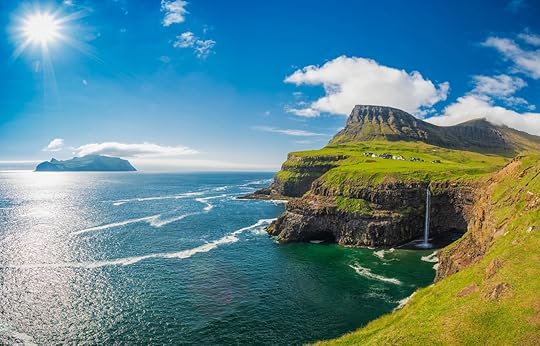
Photo: Dmitry Pistrov/Shutterstock
Flights to the Faroe Islands only operate from Edinburgh, Bergen, Reykjavik, and Copenhagen, and land at Vagar Airport on the island of Vagar. When you land, pick up your car from the rental building next door and drive 45 minutes to Torshavn, which is located on the largest island, Streymoy.
You certainly won’t be starved for impressive scenery on the drive, but for a quick excursion right after you arrive, stay on the island of Vagar and head 10 minutes west from the airport to the town of Bøur. There you’ll find viewpoints of the islands’ most iconic sea stacks: Tindhólmur and Drangarnir. Another 10 minutes will bring you to the Múlafossur waterfall. It’s only a five-minute walk along the cliff’s edge until you can see the falls, which tumble 100 feet down a precipice.
Once you do set a course for Streymoy Island and the capital, Torshavn, you can choose from several hotels in the city center. If you’d prefer a more country-esque experience and fantastic views of the city and the ocean, check out Hotel Føroyar about five minutes from town. Built into the hillside with tiers of green roofs, the modern hotel is a half-hour walk from the city and a comfortable base for the rest of your adventures.
Streymoy and Eysturoy Islands
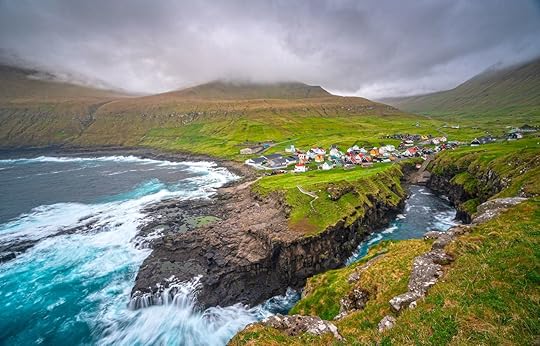
Photo: FCG/Shutterstock
As you look down on the small coastal fishing villages from high mountain roads, or stop to walk their streets, you’ll quickly realize that these aren’t typical tourist destinations. You won’t find elaborate tourism infrastructure with museums, visitor centers, or hiking trails marked by giant signs. The larger villages are home to a few dozen people, while the smaller ones might have populations as low as seven. That’s what makes a road trip here so unique.
One of the most breathtaking islands, and also one of the easiest to access, is Eysturoy — right next to Streymoy. Drive northeast from Torshavn and pass through the underwater tunnel to Eysturoy, then head north along the water to Funningur and Gjov. Whether you choose to explore Funningur, a town of 70, or simply photograph it from the mountainside viewpoint, you’ll be looking at a perfect example of a classic Faroese town. Situated on the banks of an inlet, in the shadow of a dramatic green valley, Funningur gives you a sense of the many more stunning vistas you’ll experience.

Photo: ronnybas frimages/Shutterstock
Just 15 minutes farther down the road, the town of Gjogv has only around 50 residents, but it’s one of the island’s most popular spots for hiking and wildlife. About an hour’s hike from town will bring you to the Ambadalur Valley — a massive expanse of untouched green land with fantastic views of Búgvin, the largest sea stack in the Faroe Islands. Gjogv’s seaside cliffs are also home to a small puffin colony.
If you want to be absolutely certain of seeing puffins, you’ll have to go farther north to the island of Mykines, but that requires a ferry and may not be quite as convenient. The puffins near Gjov are less numerous, and appear less frequently, but if you’re lucky you’ll catch a glimpse before you continue your journey west.
Your journey from Torshavn to Gjov, even with a stop in Funningur and a short hike to Ambadalur, probably won’t take more than a few hours. That means it’s probably time for lunch. The problem is, there isn’t an abundance of restaurants in the Faroe Islands, as the Faroese are largely accustomed to cooking their own food and eating at home.

Photo: Eben Diskin
That’s what makes the Sand Cafe in Tjørnuvík such a welcome sight. Just a 45-minute drive from Gjogv, Tjørnuvík is located on the northeast coast of Streymoy Island. Simply return to Streymoy via the tunnel, then head north along the coast. The only eatery in this small town, the Sand Cafe serves cod, salmon, fish soup, and pancakes; since it’s located right on the black sand beach, you can enjoy views of the steep cliffs and sea stacks while you sip your coffee.
If you feel like making one more stops before heading back to Torshavn, take a half-hour detour to the small village of Saksun. Also on Streymoy, Saksun is home to a whopping 14 residents. It’s known for its sod houses with grass-covered roofs and a lagoon that sits at the foot of the village. The remote village is accessible via a single-lane road, and getting there will truly feel like you’re driving not only into the middle of nowhere but also back in time.
Even more remote islands you can reach by ferry
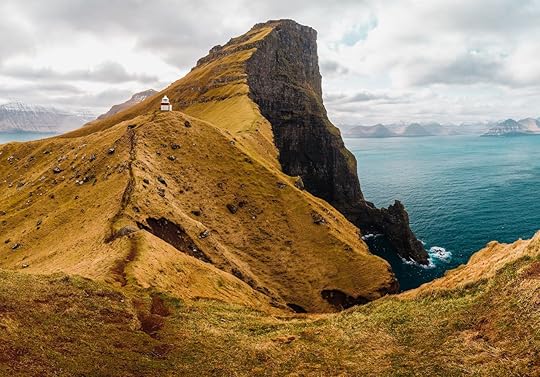
Photo: Yannik Photography/Shutterstock
Some of the most stunning scenery in the archipelago lies on remote island only accessible via ferry. The island of Kalsoy, for example, has just a few villages with a combined population of around 150. It’s so peaceful, Streymoy and Eysturoy feel bustling in comparison. Fortunately, the ferries accommodate cars and, if you get an early start, you can be in Kalsoy by mid-morning.
Just drive an hour east from Torshavn to Klaksvik on the island of Borðoy. You’ll take two tunnels to get there, as you cross the isle of Eysturoy on the way. From Klaksvik, it’s only a 20-minute ferry ride to Kalsoy. Kallur Lighthouse might be Kalsoy’s main attraction, but getting there is arguably even more memorable.
The first village you’ll encounter as you drive north along Kalsoy’s lone road is Mikladalur, the largest village on Kalsoy with fewer than 30 permanent residents. Stop to visit the mermaid, or selkie, statue. Standing at nine feet tall, this bronze statue commemorates the local myth of a seal who shed its skin on land to become a woman. A few steps from the statue, a cafe is currently in the process of being built, so if you visit Mikladalur a year from now you’ll be able to enjoy some coffee and dessert while you look out on the statue and water.
From Mikladalur, it’s less than a 10-minute drive to Trøllanes, which will serve as the base for your hike to Kallur Lighthouse. Trøllanes is even smaller than Mikladalur with just 13 permanent residents — though it often appears busier due to the visitors coming to see the lighthouse. The hike shouldn’t take more than a half hour, but the unmarked trail can get pretty steep and muddy, so be sure to dress accordingly. Against the backdrop of steep cliffs, and waves crashing against the crags below, the simple red-and-white lighthouse is easily one of the most dramatic views in the Faroes.
Even wilder islands

Photo: EyesTravelling/Shutterstock
If you talk to enough Faroese people, you’ll quickly learn that everyone has a “favorite island.” For many, that island is Suðuroy. Getting to Suðuroy, the southernmost island in the archipelago, requires a bit more commitment — as the ferry ride from Torshavn is about two hours long. You’ll be glad you did, though, as it may be the most remote island you’ll visit.
This island of sea cliffs is home to some of the best unspoiled natural scenery in the Faroes, including Trongisvágsfjørður, arguably the most beautiful fjord on all the islands. It has incredible hikes, and the Hvannhagi trek — located in Tvøroyri, right near the ferry terminal — is one of the most popular. Hvannhagi is famous for its unique geological elements, including stones that crashed into the area from avalanches thousands of years ago, a beautiful lake, and green fields dotted with sheep. You’ll also be rewarded with views of the islands of Lítla Dímun, Stóra Dímun, and Sandoy.
Just a 13-minute drive northwest of Tvøroyri is the town of Hvalba, which is known for its black-sand beach. If you’re still exhausted from the Hvannhagi hike, you can take a leisurely stroll along the beach and enjoy the views across the bay. If you’re up for more of a challenge, take the short hike to the sea cliffs of Norðbergseiði, which takes you past a quiet lake and culminates in views of rough waves crashing against the cliffside below.
To give your feet a rest, finish your trip tp Suðuroy with a boat tour of the cliffs on the island’s west coast. The RIB62 tour company, owned by locals from Hvalba, operates tours that give you a sea-level view of the vertical cliffs, hidden cafes, and seabirds inhabiting the crags. While it might sound like an excursion designed for tourists, Faroese people themselves will tell you that this tour of Suðuroy is one of the most scenic experiences in the Faroe Islands.
Seeing it all from the sky

Photo: Curioso/Shutterstock
A car might be the easiest way to get around the Faroe Islands, but if you ever get a chance to travel by helicopter, take it. The views of the cliffs, sea stacks, waterfalls, and crashing waves might be cool from the car, but just wait until you see it all from the air.
Usually helicopters come with a hefty price tag, but in the Faroe Islands, people use them not as a novelty but as a practical way of getting around. Atlantic Airlines, the official airline of the Faroes, also operates a helicopter service that is government subsidized, making it affordable for both locals and visitors alike.

Photo: ABB Photo/Shutterstock
If you don’t want to take a two-hour ferry to Suðuroy, for example, you could take a 40-minute helicopter ride instead. A helicopter can also take you to the northernmost island of Fugloy, which has a total population of thirty-seven. It’s important to note, however, that because helicopters are used almost like taxis by the Faroese, routes are often one-way only. That means you’ll need to find alternative means of transportation back, or prepare to be roommates with the local sheep.
For those who want a quick helicopter experience without complicating their logistics too much, you can fly from Torshavn to the airport in Vagar. The flight costs around $30, and while it only lasts 15 minutes, it will easily be one of the most memorable parts of your trip. You can save this flight for your last day, when you need to head to the airport anyway, or simply catch a bus from the airport back to Torshavn. It really is the perfect way to cap off an adventurous trip to the Faroes. 

More like this: Why the mighty, wild Faroe Islands belong on your bucket list
The post Island hopping by car in the wild Faroe Islands appeared first on Matador Network.

Countries with the most chocolate

Few foods are as beloved as chocolate. In the United States, it feels like chocolate is everywhere you look: dessert menus, grocery store aisles, the back corner of the cupboard with the rest of the leftover Halloween candy from 2015. It makes you wonder, where does all this chocolate come from?
By compiling studies from Forbes, international trade centers, and market research groups, the business education site World’s Top Exports broke down where the most candy and dessert chocolate is produced before being sent around the world. European countries lead the pack by a long shot, with more than 73 percent of chocolate exports coming from a European country. These are the 10 countries, in order, that export the most chocolate:
Germany
Belgium
Italy
Netherlands
Poland
United States
Canada
France
United Kingdom
Switzerland
It only takes a quick look at the list to notice a glaringly obvious fact: Chocolate is typically not produced in the tropical regions of the world where its key ingredient, cocoa, is grown. Yet the story behind how many of these non-cocoa growing countries became the world’s most prominent chocolate producers is not so sweet.
Chocolate is made from cocoa, which are the roasted beans of the cacao tree. The plant is native to Central and South America, and there’s evidence of people consuming a cocoa drink as far back as 1500 BCE. The Mayan and Aztec civilizations drank cocoa mixed with chili, honey, and water. It’s unclear how chocolate first got to Europe, with some reports citing Christopher Columbus, others Hernan Cortes, and others still who say it first came as a gift to the king of Spain from a friar returning from the Americas.
It took time for Europeans to get a taste for chocolate, but by the 1600s, other colonial countries like Italy, Portugal, the Netherlands, France, and England were importing chocolate. Cacao trees were brought to Africa, islands in the Caribbean, and the Dutch brought it to modern-day Indonesia. It was still consumed primarily as a drink until the latter half of the 19th century when one Swiss man created milk chocolate in 1876 and another invented the conch machine in 1879, which made chocolate easier to chew and melt in your mouth.
Chocolate demand continued to increase all the while in Europe, leading to more plantations in colonies in the Americas, Southeast Asia, and Africa. These plantations largely relied on slave labor or fields with dismal working conditions.
Many of the world’s largest producers of chocolate were once colonial countries that relied on the exploitation of people and land. Belgium, for example, largely sourced its cocoa from the Congo, while companies in England and Germany bought cocoa from Portuguese slave plantations in West Africa. Through the years following World War I, the largest chocolate manufacturers in England and Germany tried, and mostly failed, to source from ethical growers, Lowell Joseph Satre writes in Chocolate on Trial: Slavery, Politics, and the Ethics of Business.
The impact of colonialism survives today: Many countries guilty of colonization make most of the finished chocolate sold around the world, still importing their cocoa from the countries they once occupied. West Africa still produces, by far, the most cocoa in the world, according to World Atlas. These are the top cocoa-producing countries in the world:
1. Côte d’Ivoire
2. Ghana
3. Indonesia
4. Nigeria
5. Cameroon
6. Brazil
7. Ecuador
8. Mexico
9. Peru
10. Dominican Republic
Thankfully, today there are working good conditions in some of these countries, but the Anti-Slavery Society, which fought against sourcing from Portugal’s West African slave plantations in the early 1900s, still lists chocolate as an industry well known for using child labor alongside the diamond and fashion industries. More than two million children work in cocoa fields in Ghana and Côte d’Ivoire for less than $1 per day, according to the US Department of Labor.
Chocolate consumption doesn’t appear to be slowing down anytime soon. World Top Exports found that chocolate exports rose by four percent every year from 2014 to 2018, with sales rising fastest in Poland, Italy, Canada, and Mexico. So, as you’re standing in the candy aisle pondering the long history that led to where all the chocolate comes from, maybe also keep in mind the ethical scorecard of the world’s chocolate companies. 

More like this: This scorecard will tell you if your favorite chocolate was made with child labor
The post Where all the chocolate you eat really comes from appeared first on Matador Network.

What is Samhain and how to celebrate

Many of us have heard some version of the same Halloween origin story: The traditions in the United States, such as dressing up in costumes and going trick-or-treating, actually stem from a pagan festival called Samhain (pronounced sah-win). It was likely heard in grade school, and — content with creepy masks, demanding candy from our neighbors, and haunted houses — most people probably never bothered to explore the issue further. Yet today, Samhain traditions live on, including in the US.
The spread of Christianity squashed most pagan rituals, leaving behind just a shadow of what the original Gaelic (peoples native to Ireland and Scotland) revelers celebrated. Modern Halloween celebrations and Samhain have very little in common — though both occasions call for big parties.
Some 2,000 years ago, Samhain marked the end of harvest and the beginning of winter. It was a time of spiritual importance to the ancient Celts, who were attuned to the mysticism and faerie realm. During Samhain, they believed that the veil between the world of mortals (our world) and that of the spirits, or aos si, became thin. This allowed the living to communicate with their dearly departed, and people held feasts in their honor, sometimes setting a place for them at the family dinner table. According to historian Ronald Hutton, author of Stations of the Sun, groups of revelers donned costumes (meant to either imitate the aos si, or provide protection from them), reciting songs and acting out plays in exchange for food from their neighbors — one possible origin of modern trick-or-treating.
Though many of the customs associated with the original Samhain have been distorted, appropriated, or lost to memory, Samhain is far from forgotten. Modern Wiccans and other pagans (Wicca is a subset of paganism; Druids are another example) of all stripes have kept the tradition alive, adapting their Samhain festivities to suit the contemporary pagan community. These days, Samhain is celebrated with less much mischief but it remains a holiday imbued with spiritual power.
Observed primarily in Wiccan covens (a gathering of witches), modern Samhain celebrations call for a ritual that’s sometimes accompanied by a feast or potluck. Many covens throughout the country — which are often legally classified as churches and presided over by a high priestess — offer non-practicing people a chance to experience Samhain through a public ritual.
What a traditional Samhain ritual is like

Photo: Erwin Dimal/Shutterstock
“We hold church services for the eight sabbats throughout the wheel of the year [a cycle of annual celebrations observed by modern pagans, including Yule and Beltane] and some of our celebration days are also held publicly,” says Rev. Debra Jeffreys, high priestess and founder of Bee Hive Coven in Metairie, Louisiana. “Samhain is one of those sabbats.”
Jeffreys explains that Samhain is sometimes known as the Witch’s New Year. Samhain is the darkest period of the wheel of the year, coming just before Yule, when the light returns and the days get longer. “While we’re in the dark, we need to think about, what did you do last year? Did your plans come to fruition? Or maybe you have new plans? It’s a time of contemplation,” she says.
The Bee Hive Coven Samhain ritual is a free event open to anyone — initiated church members, amateur Wiccans, and curious members of the community alike. It’s intended to “honor those who have died and crossed over the veil, because it’s easier to communicate at this time of the year,” Jeffreys says.

Photo: moibalkon/Shutterstock
Jeffreys and Ronnie Murphy, the coven’s high priest, lead the ritual. Guests must be “cleansed and blessed” before they can enter the sacred circle. “Usually they’re anointed with oil and smudged with incense that represents the elements and cleanses you from your day to day life and negativity, so you’re entering fresh,” Jeffreys says. “We always ask how do you come to circle? [We say,] ‘You come to circle of your own free will and you enter circle in perfect love and perfect trust’.”
Participants in the ritual typically stand in a circle, holding hands, and will have the chance to name the loved ones they’ve lost during the year. Part of the Wiccan belief system dictates that those who are remembered by the living can never really die, according to Jeffreys. An altar, which holds objects like candles and incense, as well the communion-like offering of cakes and ale, is the focal point of the ritual. Once all of this in place, the ritual can begin.
“We call in the four elements to help build our circle and then we’ll call in Deity to be with us during the ritual,” Jeffreys says. “Usually Samhain will be on a somber note, remembering the people that we’ve lost, looking forward to the new year and things that we want to try to accomplish.”
During Samhain, you remember the past and plan for the future.
Another element of Samhain is the silent supper (traditionally known as the “dumb supper”) which Jeffreys holds privately in her home with friends and church members. During the potluck dinner, guests bring a dish representing their family heritage, as well as mementos for the ancestor altar that represents their departed loved ones. A place is set at the table to honor the dead. The meal itself is held in complete silence.
“We give up our voice for those that have crossed the veil so that we can eat in silence and hopefully hear from them and honor them and acknowledge them,” says Jeffreys.
A chance to learn about Wiccan culture

Photo: 1000 Words/Shutterstock
In Asheville, North Carolina, high priestess Queen Lady Passion holds public Samhain rituals for teens and adults. This year’s theme is “Witch Bling,” but she’s never held the same Samhain celebration twice. Past events have included mass handfasting (or wedding) rites, “creepy” music, costumed characters, traditional dancing, and a (metaphorical) journey through the underworld concluding with reincarnation. She doesn’t pick the theme herself, but rather waits “for God/desses to tell me what They want theme-wise.” Then she spends months constructing their vision.
“When I wanted to create a fairy realm, I bought dozens of Barbies and dressed them in diverse natural things like leather, feathers, tinsel, lamé, and posed them atop glowing ‘toadstools’ I made from upside down glow-in-the-dark bowls and painted stems,” the high priestess explains. “I had folk swoop down from treetops, live drummers, and flutists.”
Queen Lady Passion doesn’t outline much etiquette or set strict rules for the participants, but she does want them to do more than just stare.
“We just demand physical participation and reverence,” she explains. “I’ll politely kick out anyone who demurs or radiates a negative vibe. Participants feel wiped out, having given it their all, but also changed, heartened in difficult to articulate ways.”
Queen Lady Passion began holding public rituals in order “to disabuse bigots of their negative notions and assumptions, and to show parents and children the joy of circling and dancing hand-in-hand.”
Bee Hive Coven’s reasons for inviting the public to celebrate Samhain are much the same. They want to provide a safe space for curious people to ask questions and hopefully dispel stereotypes about Wiccans. Murphy laughs recounting the number of times he’s encountered people asking if witches fly or sacrifice babies.
“Our purpose is education and mainstreaming,” Jeffreys says. “We are the people next door, we are your normal everyday person. We just happen to see deities differently than the mainstream. Being a witch, or a pagan, or a wiccan — it’s not a bad word.”
Public Samhain celebrations you can join
You can find almost every Samhain celebration around the country listed at Witch Vox. Here are five to get started.
Pittsburgh Witches Ball: The longest running witch’s ball takes place in Pittsburgh on November 9. Here, pagan-minded people gather for a night of live music, dancing, tarot card readings, and a buffet. Guests can bring items to honor any loved ones who passed away in the past year to add to the altar. This year’s theme is River Styx. Tickets are $35 ahead of time, and $45 at the door.
Where: American Serbian Club 2524 Sarah Street, South Side, Pittsburgh, PA 1520
Spirit’s Edge Samhain: The Spirit’s Edge Shamonial Temple in Missouri holds public rituals throughout the year. This year’s Samhain celebration will take place on November 2, and includes “A Seeker’s Salon” before the ritual where guests can discuss and learn more about Wiccan traditions. The ritual will be followed by a potluck and a chance to get to know the other participants. Anyone is welcome and the event is free.
Where: 1155 S Rock Hill Rd, Webster Groves, MO 63119
Michigan Witches’ Ball: The 23rd annual Michigan Witches’ Ball welcomes goths, pagans, druids, and witches to celebrate Samhain and “promote religious tolerance.” This year’s party takes place on October 19, and the theme is “Wondrous Tales.” Tickets are $50 and the event is for ages 21 and over. A raffle will also be held to benefit the Michigan Pagan Scholarship Fund.
Where: Royalty House 8201 East 13 Mile Road Warren, MI 48093
Samhain Ball: This Samhain celebration in upstate New York is hosted by Pagans in the Pub, a monthly meetup open to the public’s pagan community. The Samhain Ball takes place at the local Unitarian church. The ball holds a ritual and a costume contest, and snacks and mead will be served. Admission is $20.
Where: 109 Browns Rd, Huntington, New York 11743
Seattle Reclaiming Samhain: Seattle’s Samhain ritual takes place on ancestral Duwamish land, and part of the proceeds go to Real Rent Duwamish. This “clean and sober” ritual requires that participants bring pillows, mats, or chairs for the “90 minutes of magic” that includes a trance as well as a spiritual dance accompanied by drumming. Tickets are anywhere from $20 to $13 dollars, but no one will be turned away for a lack of money.
Where: 1018 NE 112th St #1020, Seattle, WA 

More like this: 7 fascinating Halloween traditions around the world
The post How to celebrate Wiccan Samhain instead of Halloween this year appeared first on Matador Network.

“It”-themed Chicago bar opens

Halloween is approaching, so it was only a matter of time before spooky pop-up experiences started to, well, pop up everywhere. This one is particularly terrifying, especially if you’re one of those people whose nightmares frequently involve clowns. “The Losers Club” is an It-themed pop-up bar, created by Replay Lincoln Park, an arcade bar in Chicago. The bar transports you right into the Stephen King novel, which takes place in Derry, Maine.

Photo: Replay Lincoln Park/Facebook
The pop-up isn’t located in Derry, but it certainly does its best Maine impression. You’ll find familiar sights from both the book and movie versions, including the abandoned house near the train yard; encounter the members of the Losers Club; and, of course, come face to face with Pennywise. There will also be a funhouse full of mirrors in the arcade bar, a popcorn machine, and events hosted throughout the month like It costume contests and trivia.

Photo: Replay Lincoln Park/Facebook
You should also keep an eye out for specialty cocktails, with names like Pennywise Punch — dark and light spiced rum with passion fruit and citrus juices — and the SS Georgie, which is basically a rye Old Fashioned with a Luxardo cherry liqueur float. There are also three doors at the bar labeled “Scary, Not Scary, and Very Scary,” next to three shots with the same names. So choose wisely.
The pop-up opened on October 11 and continues through Halloween. 

More like this: 7 fascinating Halloween traditions around the world
The post A chilling “It”-themed pop-up bar is coming to Chicago appeared first on Matador Network.

Pay your parking ticket with food

There’s nothing worse than losing a month’s paycheck on blackjack, then stumbling out of the casino at 4:00 AM to find a parking ticket on your windshield. Assuming you didn’t also gamble away your entire food pantry, now you’ll still be able to pay it off. If you find yourself in Las Vegas between October 16 and November 16, and you receive a parking citation, you will now be able to donate food instead of paying a cash fine. The Las Vegas city council voted unanimously to enact this new measure, with the aim of helping those in need this holiday season.
According to the press release, “Those who have a non-public safety parking infraction in the city of Las Vegas between now and Nov. 16 may resolve their tickets by bringing in non-perishable food items of equal or greater value to their fine to the Parking Services Offices at 500 S. Main St. This must be done within 30 days of the citation date and a purchase receipt for the donation is required. Food items for tickets will be collected until Dec. 16, 2019.”
Donations will be donated to the Helping Hands of Vegas Valley, a nonprofit organization that offers assistance to low income and disabled senior citizens.
Keep in mind, however, that this new rule doesn’t apply to every single traffic violation. Several tickets are excluded from the program, including red curb, fire lane, handicap, double parking, and bike lane violations. 

More like this: 7 cultured experiences to have in Las Vegas
The post Las Vegas will let you pay your parking tickets with a food donation this month appeared first on Matador Network.

Tasmanian tiger sightings

It’s not exactly Bigfoot, but a Tasmanian tiger sighting is still pretty incredible. The animal was thought to have gone extinct over 80 years ago, but according to new Australian government documents, it was reportedly spotted just a few months ago. The released document from Tasmania’s Department of Primary Industries, Parks, Water and Environment claims there have been eight sightings of the tiger in the past three years. Crossed between a wolf, fox, and large cat, the Tasmanian tiger was believed to have gone extinct in 1936, when the last known member of the species died in captivity.
The creature’s extinction was owed in part to European colonists killing thousands of them for attacking sheep.
One report from last February details the experience of two people visiting Tasmania from Australia. While driving, an animal with a stiff tail and striped back walked onto the road, looked at the vehicle a couple of times, and other people in the car were “100 percent certain that the animal they saw was a thylacine (Tasmanian tiger).”
Another report, filed the same month, described the creature moving through the mist in the distance. “I am accustomed to coming across most animals working on rural farms,” it said, “and I have never come across an animal anything close to what I saw in Tasmania that day.”
Despite these reports, there has been no actual, verifiable evidence that the creature has made a comeback. 

More like this: 10 endangered animals to see (and save) before they’re gone
The post Several sightings of the extinct Tasmanian tiger have been reported in Australia appeared first on Matador Network.

How to sail the coastline of Turkey

The southeastern corner of Turkey is a twisty coastline that looks like gnarled branches reaching into the Mediterranean — a collection of forested peninsulas, rocky inlets, and hidden coves. Dozens of islands lie just offshore, among them tiny, uninhabited islets claimed by Turkey. Most of the larger, populated isles, even those merely two miles from the Turkish mainland, belong to Greece. It’s a stunning corner of the world that begs to be discovered, and the best way to do so is on a week-long boat trip.
Situated at the crossroads between Europe and the fertile lands of Anatolia, Turkey’s Asian side, this region was once vitally important to the seafarers of the early Greek, Roman, and Byzantine empires. Nowadays, though, the fortified castles that once protected against invaders in coastal cities like Bodrum are now museums. The watery havens that long ago held trading vessels and warships are today picturesque marinas.
Travelers depart from these marinas to swim in quiet bays of clear azure water surrounded by wooded hillsides of pine and cypress; to smell the wild herbs growing in natural reserves where brown and black goats maneuver impossibly steep inclines; to marvel at stone cliffs that soar hundreds of feet up from the sea. By night, they’ll anchor near picturesque resort towns with seaside restaurants and late-night markets.
Options for booking a boat trip
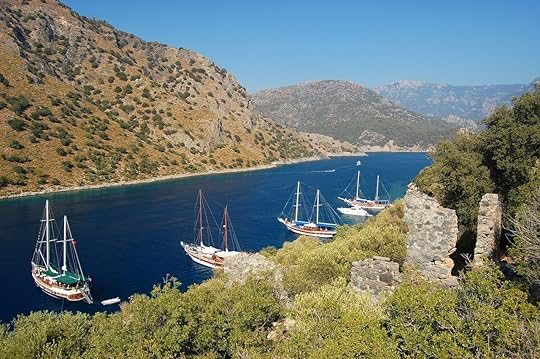
Photo: Pawel Kazmierczak/Shutterstock
The most popular way to explore the Turkish coastline is on a gulet, a motorized sailboat that will likely seldom go under sail. If you opt for a private boat, Durukos Yachting is a family-owned business based in Bodrum that charters boats and crews. A boat with four cabins may come with a crew of three or four: the captain, the first mate, the galley chef, and perhaps another crew member.
Getting a private boat is not cheap, and is the kind of thing you might do for a special occasion like a major birthday. Or, if your boat has four en suite cabins — not including the area for the crew — you could get four couples in on it together for a blow-out vacation. Gulets come in different sizes and configurations, making some better suited to your group than others. If you do go the private route, you should book well in advance, as by May there may no boats left for an August excursion.
A cheaper alternative to private gulets is booking as part of a tour with a set itinerary. Some of these options are not for families, but rather for adults aged 18 to 39, who are read to spend a week relaxing, bonding, and partying with their new-found friends. Companies like TourRadar book with local operators for as low as $600 for the week, with most meals included. MedSailors operates actual sailboats that take longer to get places, but that means you’ll spend less time motoring. You can book solo, as a couple, or gather a big group of eight to 12 friends. Prices vary by vessel and by summer month; you could pay as little as $700 per person in late May and quite a bit more in August.
When you research options, check whether meals are included — although fortunately food is relatively inexpensive in Turkey. If you do go private, you can state your food preferences ahead of time. Depending on where you anchor, an entrepreneurial local may also pull up in a small motorboat selling fresh village breads baked in their home. Some boats serve nearly all meals onboard, but two per day might be better so you can visit restaurants at your ports of call.
No matter which option you choose, try to get Turkish-style breakfasts onboard since they really are the best breakfasts in the world. And nothing beats waking up, jumping into the sea, and then sitting down to an array of breads, eggs, cress, tomatoes, diverse cheeses and jams, tahini, olives, and fruit spread out on the table.
Departing from Bodrum
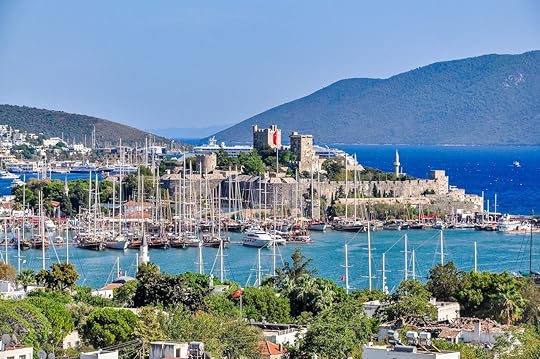
Photo: Tomasz Czajkowski/Shutterstock
Bodrum, a one-hour flight from Istanbul, is the most popular departure point, and a typical schedule will have you leave Bodrum on Saturday afternoon, returning on Saturday morning a week later. (MedSailors, however, sails off from Göcek, a much smaller marina in a lovely area due south of Bodrum.) While Bodrum can be hot and crowded in the summer, its castle is worth a visit — not least for its view out over the bay.
Although the castle was built in the 1400s during the Ottoman Empire, the museum within it has artifacts from several nearby shipwrecks as far back as 2,500 years ago. You’ll see hundreds of amphorae, or conical ceramic jugs, that once transported wine, olive oil, Roman coins that lay unused on the seafloor, and even age-old swords. You’ll sense the deep history of trading, invasion, and conquest that preceded the holiday vibe of today.

Photo: Noelle Alejandra Salmi/Shutterstock
Where you go depends on the itinerary you’ve booked, but in any case be prepared for small changes if winds come up. Your captain may opt to spend less time on the open water between destinations or may anchor at a more protected cove for the night. Regardless of where you head, you’re likely to wake up in a quiet cove that feels a world away from the bustle of Bodrum.
The Datça Peninsula
Package tours like those booked through TourRadar stay on the southern end of the Bodrum Peninsula, while MedSailors sails by the Fethiye Peninsula. Should you explore the Datça Peninsula, which lies between those two regions, you’ll visit Turkish resort areas where you’ll hear little or no English. A portion of the Datça Peninsula is a protected reserve, and you may find yourself in a quiet bay surrounded by hillsides where wild herbs grow and agile goats nibble on tasty shrubs.

Photo: Dudarev Mikhail/Shutterstock
Bring good books and portable games that won’t blow away in the breeze, like Liar’s Dice. No matter where you cruise, spending a lot of time in the water will be part of the itinerary. You’ll be jumping off the boat aplenty, and possibly swimming to sea caves, where the sunlight filters through to make a brilliant aquamarine hue. If you bring reef booties, you could try to find cliff sides to scamper up and then jump off. (Ask your captain first whether it’s deep enough!)
Check before you travel whether your gulet has water toys like stand-up paddle boards. If you have the luxury of a private gulet, you could ask them to supply gear like windsurf boards and water skis at no additional charge. You could swim every day before breakfast, and find running routes in some towns like Bozburun, where you can head up into the hills and look down at the town of Selimiye.
Evenings on the Datça Peninsula

Photo: fotopanorama360/Shutterstock
If you are in Bozburun, have dinner at the edge of town, your table right by the water, at the peaceful Bozburun Yacht Club. In Selimiye, the town on the opposite side of the Datça Peninsula from Bozburun, you may find stores selling international brands, but you’ll also find plenty of local artisans making beach jewelry and not a single international hotel chain.
Be sure to order some goat milk ice cream from one of the many vendors. They’ll play all sorts of games with you — almost like magic tricks with disappearing ice cream and multi-stacked cones — before relenting and serving up the curiously sticky, but intensely flavored, frozen treat.
If you’d like to venture to a Greek island, you’ll have to go to a town with an immigration control like Datça. You can explore Datça by night, where you can choose from several restaurants with tables set right out on the sand and lit by festive lanterns or strings of lights. Dine on small meze plates of yogurt dips, fried anchovies, roasted eggplant, and other goodies, followed by a whole roasted fish. (Be sure you know the exact price of the fish in advance.) Then wander along the wooden promenade toward the upscale late-night craft market.
The Greek island of Symi
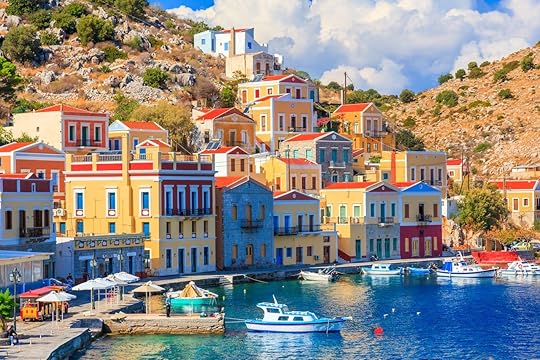
Photo: Ian woolcock/Shutterstock
The Greek island of Symi lies very close to Datça. Once your captain has sorted out your immigration forms (probably with you in tow), you can head toward Symi. There, you’ll have to show your passport before anchoring. Symi feels much more international, and you’ll find boutiques and bars owned either by Greeks or Europeans of other nationalities. In Symi, have dinner at the edge of the harbor at Tholos, where you’ll be seated under olive trees with a view of the harbor lights beyond.
After departing Symi Harbor, head to the narrow, stunning Agios Georgios, or Saint George Bay, on the island’s eastern side. There, cliffs soar upward of 300 feet from the sea, yet the water is deep enough to accommodate sizeable sailboats. Swim ashore to explore the beach’s tiny white church, highlighted by the massive rock face behind it. Be forewarned, though: The beach is composed of tiny rocks, and you’ll want those reef shoes.

Photo: Noelle Alejandra Salmi/Shutterstock
Another potential stop is Knidos, a city-sized museum of relics that date to 300 BC. Stunningly situated by a narrow isthmus with two protected harbors, Knidos was a major center in the ancient Greek Empire, which now is part of Turkey. Take a moment to walk to the top of the amphitheater for an incredible view of both harbors.
Walk a little further up the hills of this ancient metropolis, as we did on our last day, and you’ll find a still-functioning sundial. As the sun lowered on the horizon, the sundial confirmed for us that nighttime was not far away — and that, sadly, our cruise back to Bodrum, where we’d spend our last night on the boat, was just a couple of hours away. 

More like this: On your next trip to Turkey, get out of Istanbul and head to Izmir
The post Exploring Turkey’s stunning Mediterranean coastline by boat appeared first on Matador Network.

October 16, 2019
International bleisure destinations

The concept of bleisure travel — combining a work trip with free leisure time for activities like urban sightseeing — has taken US cities by storm in recent years, transforming business travel as we know it and proving that work and play don’t have to be mutually exclusive. And now, the trend is extending to overseas trips, as well. If your company is footing the bill for that international airfare and covering most of your accommodations and meals, then why not take the opportunity to see and experience a bit more of the world for a fraction of the cost?
Not all bleisure cities are created equal, requiring factors like solid public transportation, top-notch infrastructure with digital connectivity and modern amenities, orderliness, safety, and a wealth of leisure activities like local dining experiences, museums, and more. Checking all the bleisure boxes, these cities are embracing their new identities as top international destinations for bleisure travel.
1. Tokyo

Photo: Sean Pavone/Shutterstock
Asia is one of the fastest-growing destinations in the bleisure travel trend, and Tokyo sails above the competition. Japan’s capital city of over nine million is a major hub for industries like consumer electronics, automobiles, and manufacturing; combine that with the recent boom in tourism, and Tokyo is ripe for bleisure-time fun. Served by two major international airports, business travelers love the city’s fast and reliable public transportation, rich blend of historic culture with modern innovation, stunning architecture and cityscapes, world-class gastronomy, and high ranking as a safe city. And with a business culture focused on formality, efficiency, and proper etiquette, Japanese hosts are committed to showing visiting guests a good time during and after business hours, with after-work drinks and meals taken in izakaya gastro pubs.
But travelers can easily navigate the city on their own, and Japanese society’s high premium on politeness means that it’s easy to ask for help or assistance. Plus, thanks to Japan’s famed high-speed rail, it’s also easy to venture out of the city for a day to see the countryside; depending on what station you leave from, Mount Fuji is anywhere from over half an hour to an hour-and-a-half away.
2. Hong Kong

Photo: ESB Professional/Shutterstock
In the elite world of high-rolling global centers, the city of Hong Kong is in a league of its own. An alpha-plus city that is one of the world’s biggest financial centers and boasts of a huge commercial shipping port, this sky-scraping contemporary metropolis towers above Victoria Harbor with a necklace of green mountains and hills at its back, providing the perfect combination of outdoor and urban adventure.
After meetings in the high-powered central business district, grab the tramcar up to the Peak, a verdant, hilltop park that has one of the best views of the city, or hop on one of the Star Ferry harbor tours to see the skyline or visit outlying islands for a taste of a more laid-back lifestyle. Dinner calls for world-famous dim sum in historic neighborhoods like Sham Shui Po, followed by partying in the legendary Lan Kwai Fong nightlife district, where there are more than 60 bars and restaurants to choose from for long nights of bar hopping, dining, and entertainment. There’s also plenty of cultural attractions like temples and museums in the heart of the city not far from offices, making it easy to squeeze in sightseeing before, after, or between work.
3. Sydney

Photo: Marina J/Shutterstock
Australia’s biggest city, Sydney makes for a great bleisure destination with its uniquely laid-back vibes, hip sensibilities, happening fusion food scene, and jaw-dropping modern skyline set against a scenic harbor. With an efficient and broad-reaching public transportation system, it’s easy to get around to all the different neighborhoods, but many of the top spots are within walking distance of the business district, like the trendy downtown area, Darling Harbor; the Royal Gardens; the Sydney Harbor Bridge, which adventurous travelers can climb to the top of; and Sydney’s crown jewel and most iconic landmark, the Opera House.
If you’ve tacked on a few extra days to your trip, spend one of them at Bondi Beach, the world-famous leisure spot and gorgeous sandy beach, perfect for sunning, swimming, surfing, supping, and shopping. While the Outback might be a bit too far away for a bleisure outing, you can still get out of town to visit Blue Mountains National Park — home of mountainous forests, winding rivers, and dramatic rocky outcrops — or the picturesque coastlines of Royal National Park.
4. London

Photo: s4svisuals/Shutterstock
“London calling!” The siren song of England’s capital city is equal parts work and hitting the town these days for bleisure travelers. A global leader for business travel, lovers of culture, history, art, and architecture will find plenty to divert and entertain during their downtime. Sightseeing tours of famous landmarks like Tower Bridge, Big Ben and the Houses of Parliament, and Buckingham Palace are a must that can be squeezed into a lunch break, as can visiting world-class museums like the British Museum or the National Gallery.
London has also undergone quite the culinary renaissance in recent years, with some of the world’s top restaurants to be found in little hole-in-the-walls or design-forward spaces, as well as deliciously diverse street eats from market food trucks. A center for theater and performance, in the evening you can take in a show at the legendary Globe Theater (where Shakespeare debuted many of his plays) or musicals and plays in the West End. There’s also tons of fashionable shopping to be had at local boutiques or high-end brands. With top-notch public transportation and easy access to Heathrow Airport, it’s also convenient to get around, and with the eastern United States just an eight-hour flight away, there’s definitely time to extend your stay for a weekend while being back to the office on Monday.
5. Singapore

Photo: PhetcharatBiRTH/Shutterstock
This island city-state of over five million was a renowned center for work and play way before Crazy Rich Asians thrust it into the spotlight. But now business travelers are getting a taste of that crazy rich lifestyle Singapore is known for. Attracting business travel for its booming manufacturing industries — as well as construction, finance, insurance, and real estate — here it’s “work hard, play harder.”
After those business meetings wrap up, hit the spectacular Gardens by the Bay installation, shop on the high-end Orchard Road to find the most fashionable and luxe brands, stroll the Marina Bay waterfront park, sightsee in the historic Geylang neighborhood, and, of course, eat your way through Singapore’s multicultural mix of cuisines at a hawker center. And the city is also a hot spot for top-notch hotels, with epic stays like the heritage Raffles Hotel or the famous Marina Bay Sands with its rooftop infinity pool.
Singapore is also home to what has, for the past seven years, been voted the best airport in the world: Changi. Ferrying 62.2 million travelers per year through its vast, airy terminals, Changi is practically a destination in and of itself, with attractions like the Jewel gardens and waterfalls (Terminal 1), movie theaters (Terminals 2 and 3), the Butterfly Garden (Terminal 3), wellness centers, art installations, a rooftop swimming pool (Terminal 1), shopping, dining, and plenty of spaces to sit, work, or recharge (all with WiFi). It’s the one airport you’d be happy to be stuck in on layover or delay.
6. Paris

Photo: RossHelen/Shutterstock
A global magnet for art, culture, fine dining, shopping, and history, Paris has long been almost exclusively thought of as a destination for leisure. But business travelers do indeed come here in the fields of banking, insurance, finance, luxury goods, and media, among others, and find much in the way of fun. The main business district, La Defense, is Europe’s biggest purpose-built business park, with a smart and efficient layout complemented by contemporary art and architecture like the Grande Arche de la Defense.
Just down the street from La Defense is the grand Champs Elysees, one of the great shopping streets of the world, as well as the Arc de Triomphe. Paris’s excellent subway system makes it easy to get around to major landmarks like the Eiffel Tower and Montmartre. Some of the best museums in the world call Paris home, like the Louvre, D’Orsay, Pompidou Center, and many more, all full of splendid art and historical artifacts. And, of course, there’s fine dining as only the French can do, with excellent restaurants and bars around every corner. While the French philosophy toward life is easy-going and prioritizes a work-life balance, there are still cultural customs surrounding business here, like punctuality. But once your work is done, embrace that famous je ne sais quoi and fall in love with the City of Lights.
7. Tel Aviv

Photo: Boris-B/Shutterstock
With a rapidly growing tech, IT, and start-up sector, as well as robust manufacturing and diamond industries, business travel to Tel Aviv is definitely on the up, as evidenced by the recent opening of chic new boutique hotels close to the startup district on Rothschild Boulevard. As a compact city, Tel Aviv’s easy to explore on foot and is also extremely safe, but taxis are also plentiful. After taking meetings during the heat of the day, things start to wind down with happy hour drinks, which are a huge part of the culture. Rooftop patios with city views are the best place to grab refreshing drinks with colleagues, followed by partying into the wee hours of the morning thanks to a thriving nightlife scene.
On off days, decamping to the warm, sandy beaches of the nearby Meditteranean for sun and swimming is a classic way to destress, but being in the Middle East, it would be remiss not to dive into the region’s rich trove of art, culture, and history, so make time to visit museums and historical sites. Exploring the city’s largest market, Carmel, is also a must, as well as partaking of the multicultural food scene. Thanks to Israel’s small size, it’s easy to give a day or two to exploring further afield, like the historic port of Jaffa, the Dead Sea, or the holy city of Jerusalem. If you’re truly ambitious, you can even hop over into Jordan to visit the lost city of Petra for a day or two.
8. Shanghai

Photo: zhao jiankang/Shutterstock
As China’s largest city and one of the great financial centers of the world, Shanghai’s outsized reputation precedes it, drawing business travelers from all over the world and China to its bustling exchange halls and offices. Most of the business infrastructure can be found in the contemporary Pudong district along the Huangpu River, with the Pudong International Airport located right on the edge of the district for fast and easy access. Taxis and a comprehensive public transportation system make it easy to get around Pudong or venture further out into the city for bleisure activities, like exploring the labyrinthine streets of the Old City, marveling at the Yu Gardens, and visiting historic temples.
One Shanghai must, though, is the Bund: a scenic waterfront promenade of beautifully preserved colonial-era buildings, as well as top-notch hotels, restaurants, and shopping. And squeezed between the glossy skyscrapers and modern architectural marvels (like the Oriental Pearl Tower) that dominate the city are other pockets of historic buildings and houses that show the city’s multicultural past (and present, as Shanghai is arguably China’s most international city in terms of expats living and working there). And, naturally, there’s tons of good eating to be had, from dumplings to noodles to steamed buns. 

More like this: This home-sharing platform for women will change the way you travel
The post The top international destinations for bleisure travel this year appeared first on Matador Network.

King Arthur tour of the UK

In a literary sense, the stories of King Arthur put England on the map. Sure, Shakespeare churned out a play or two, and Dickens may have written a few words, but the Arthurian legends lend an air of magic to England that few other stories can claim to have done. This is partly because the myths are so deeply intertwined with the country’s history, values, landscape, and traditions. The stories blur the line between fantasy and history, leaving readers with a vague sense (and hope) that some of the Arthurian legends may have actually taken place. Whether it’s the famed Lady of the Lake or Dinas Emrys, the site of Merlin’s magical birth, the legends have ignited our imaginations since childhood, leaving us with the faint hope that maybe, on some level, they were real. Many sites associated with the Arthurian stories are scattered throughout the UK, and you can still visit them today. Here’s how to take the ultimate Arthurian tour of the UK.
1. Dozmary Pool, Cornwall

Photo: Helen Hotson/Shutterstock
For your first stop on the tour, it’s only fitting to visit one of the most iconic settings associated with the King Arthur stories. In Sir Thomas Malory’s Le Morte d’Arthur, largely considered the authoritative text on Arthurian legend, Arthur was given his famous sword Excalibur by the mysterious Lady of the Lake. After Arthur was mortally wounded at the Battle of Camlann, the sword was returned to the Lady by Sir Bedivere.
The Lady of the Lake was said to reside in a small lake in Bodmin Moor, Cornwall. The moor itself is largely deserted, very much recalling the ancient England of legend, but visitors should pay special attention to Doemary Pool, the supposed home of the Lady of the Lake. The entire area, however, has been designated an Area of Outstanding Beauty and a Site of Special Scientific Interest. No, it’s not because Excalibur has been unearthed, but because traces of Neolithic artifacts were found on the shores of the pool.
2. Tintagel Castle, Cornwall

Photo: Mike Charles/Shutterstock
To truly understand the Arthurian legends, you should know the story of Tintagel Castle, where Arthur had his origins. Uther Pendragon, Arthur’s father, had been transformed by Merlin to resemble the Duke of Cornwall, who was Igraine’s husband. In this disguise, Pendragon entered Tintagel Castle and slept with Igraine, resulting in the birth of Arthur. Indeed, Arthur was not only conceived at the castle but born here as well, making it a pivotal location in the legends.
The castle sits on a peninsula on Tintagel Island, though the castle we see today doesn’t exactly date back to the Arthurian days. In the 13th century, the Earl of Cornwall was so taken by the story that he was inspired to build the castle. It had zero military or strategic purpose; it was simply an homage to the famous legend. Originally linked to the mainland by a narrow land bridge, that bridge eventually fell into disrepair, and until recently, visitors had to climb nearly 150 steps to reach the castle — much like Pendragon must have done. Just a few months ago, however, a new 223-foot bridge was built connecting Tintagel Castle to the mainland, making visiting the site easier than ever.
3. Cadbury Castle, Somerset
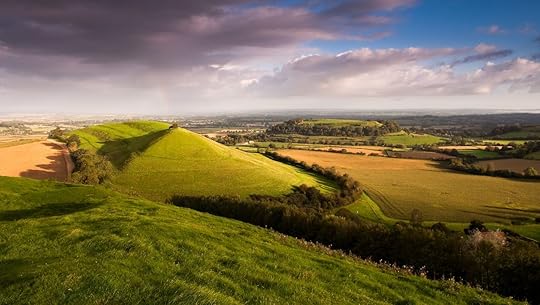
Photo: Joe Dunckley/Shutterstock
Even if you’ve never read a King Arthur story in your life, you probably still know Camelot. The seat of Arthur’s kingdom and the legendary court where the Knights of the Round Table convened, Camelot is the most central part of the Arthurian canon. Debates surrounding the location of the “real Camelot” have raged since the 1400s, and it’s unlikely that people will ever agree, but some sites certainly have better claims than others.
Cadbury Castle in Somerset has one of the best claims. No, it’s not filled with little chocolate eggs, but it was home to a warrior king named Arthur around the sixth century. Whether or not this is the same Arthur of legend is, of course, still up for debate, but the hillfort was occupied on and off for hundreds of years before falling to the Romans. The castle was first associated with Arthur in the writings of John Leland in the 1500s. “At the very south end of the church of South-Cadbyri standeth Camallate,” he wrote, “sometime a famous town or castle … The people can tell nothing there but that they have heard say Arthur much resorted to Camalat.”
Stories claim that Arthur and his knights are sleeping underneath the castle and wake every seven years on Midsummer’s Day to ride out across the land.
4. Dinas Emrys, Wales
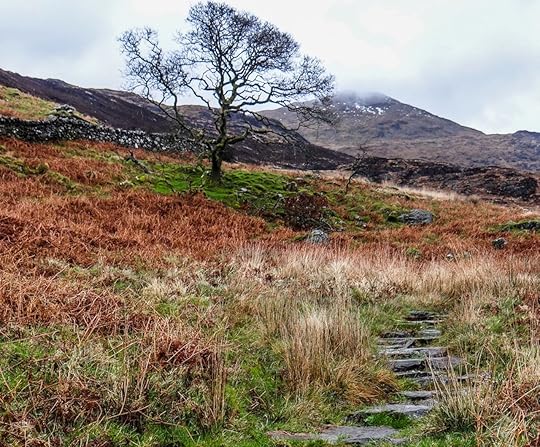
Photo: WelshHelen/Shutterstock
Especially if you’re a big fan of Disney’s animated Sword in the Stone, your favorite Arthurian character might not even be Arthur himself. Merlin, the wonky magician, is one of the legends’ most colorful characters, and though he is often shrouded in mystery, Dinas Emrys in Wales is hugely important to the character’s origins.
Located in Gwynedd in northwest Wales, this rocky hill was the place where Merlin is said to have been born amid pretty magical circumstances. Upon his birth, a white and red dragon who lived in Dinas Emrys fought each other, and the red dragon was later adopted as the national symbol of Wales. Visitors today won’t exactly be able to see the scorched earth of the dragon fight, but they can check out the remains of a stone tower built there in the 12th century, which has sweeping views of Llyn Dinas lake in Snowdonia.
5. Glastonbury Abbey and Tor, Somerset

Photo: Perception of Reality/Shutterstock
There’s no more fitting end to your King Arthur tour of the UK than the place where King Arthur himself was buried — at least, allegedly. After Arthur was fatally wounded at the Battle of Camlann, he was brought to Glastonbury Tor — otherwise known as “Avalon” — where healers attempted to save him. The Tor is a hill near Glastonbury, capped by St. Michael’s Tower. The healers failed to save the king, and he was buried on the south side of the Lady Chapel at Glastonbury Abbey, located right at the bottom of the hill. Guinevere was buried there too, when she died years later.
The remains of Glastonbury Abbey can still be visited today, and a small plaque marks the spot where the royal couple is supposedly buried. But this area is more than simply a graveyard. Right next door you’ll find the Chalice Well Gardens, so named because it’s the alleged burial place of the Holy Grail. The waters here run red, and legend holds that drinking from them has a rejuvenating effect, making it the perfect end to your King Arthur adventure through the UK. 

More like this: The 5 most beautiful places to go punting — the quintessential English pastime
The post The ultimate King Arthur tour of the UK appeared first on Matador Network.

How to see Chernobyl's control room

Twenty years ago, the idea of visiting Chernobyl would have sent chills down your spine. Now, it’s an experience many travelers are actually adding to their bucket lists. Indeed, tourism at Chernobyl has been steadily on the rise, and visitors are now able to access one of the area’s most highly radioactive sites — the control room. To visit the control room of reactor 4, visitors must wear protective suits, helmets, and masks, and they’re limited to five minutes inside the room. Afterward, you must submit to two mandatory radiology tests to ensure you haven’t been overexposed to radiation.
While visitors to the site only receive two microsieverts of radiation exposure, the control room contains radiation at 40,000 times the normal level. It looks almost identical to how it did in 1986, although many of the contaminated plastic control knobs have been removed. This heightened level of radiation exposure is why visits to the control room are so short, and why radiology tests are required.
Tourism to Chernobyl has largely been made possible by the $1.6 billion New Safe Confinement dome covering the contaminated reactor building. Ukraine has been developing Chernobyl into a full-fledged tourist destination, building new tourist routes and waterways in the area, with plans to upgrade radiation checkpoints. 

More like this: How to visit Chernobyl safely and legally
The post Chernobyl’s control room is now open to tourists — for five minutes appeared first on Matador Network.

Matador Network's Blog
- Matador Network's profile
- 6 followers



